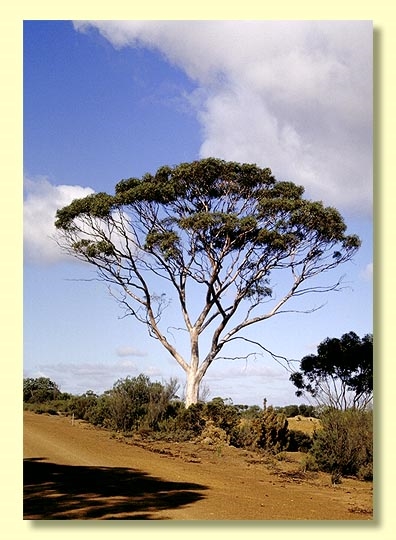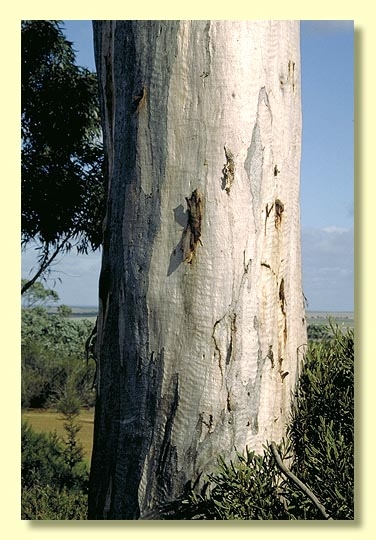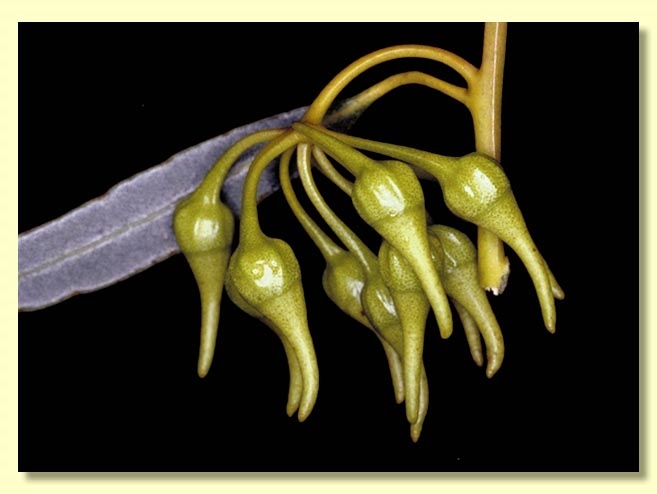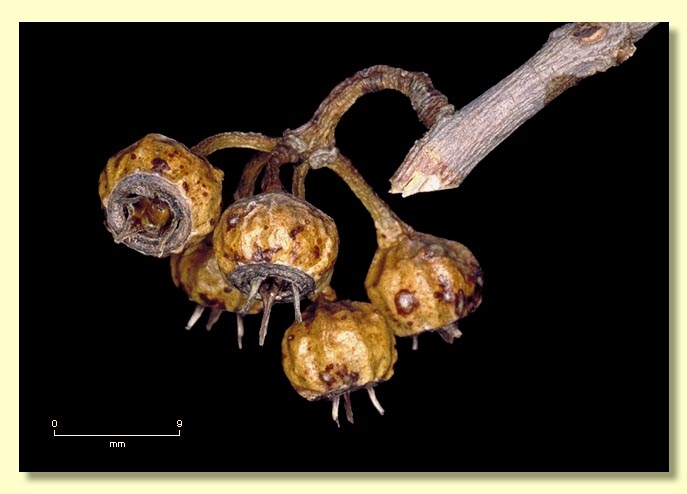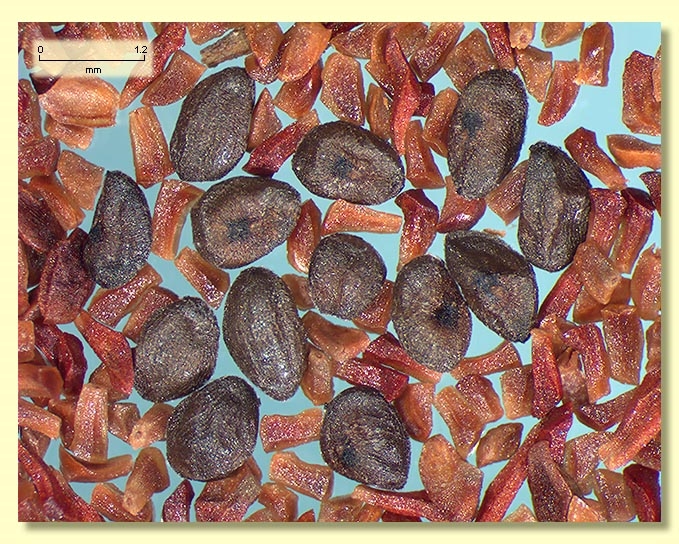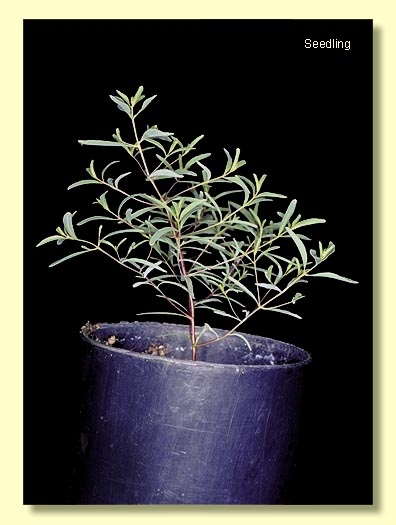Euclid - Online edition
Eucalyptus falcata
Eucalyptus | Symphyomyrtus | Bisectae | Destitutae | Falcatae | Rugatae
Eucalyptus falcata Turcz., Bulletin de la Societe Imperiale des Naturalistes de Moscou 20(1) 163 (1847).
Type citation "Nova Hollandia. Drum. coll. n. 70.". Type: Western Australia: Swan River colony, July 1844–1847, J.Drummond 4: 70; holo: KW; iso: CGE, FI, G, K, MEL, NSW, PERTH (fide Nicolle & French, Nuytsia 22: 419 2012).
Eucalyptus argyphea L.A.S.Johnson & K.D.Hill, Telopea 4: 603 (1992). T: Western Australia: 12km W of Harrismith on road to Wickepin (32° 55'S, 117° 44'E), 8 Nov. 1983, K.D.Hill 659, L.A.S.Johnson, D.F.Blaxell, M.I.H.Brooker & S.D.Hopper; holo: NSW; iso: CANB, PERTH (the CANB specimen still not received, 27 November 2019).
[Note: see note under Eucalyptus dorrienii for full explanation of why Eucalyptus falcata Turcz. replaces Eucalyptus argyphea L.A.S.Johnson & K.D.Hill as the legitimate name for these Silver mallets].
Bark smooth throughout, mottled silvery grey and pale pink-grey.
Branchlets lacking oil glands in the pith.
Juvenile growth (coppice or field seedlings to 50 cm): not seen.
Adult leaves alternate, petioles 1–2.5 cm long; blade lanceolate or sometimes falcate, (6)7–13 cm long, 0.8–2(2.2) cm wide, base tapering to petiole, margin entire, apex acute, concolorous, glossy, dark green, side-veins acute, reticulation dense, intramarginal vein very close to margin, oil glands intersectional, numerous, irregular.
Inflorescence axillary unbranched, pendulous, peduncles 1–2.5 cm long, buds 7 or 9 per umbel, pedicels 0.5–1 cm long. Mature buds elongated-ovoid, 1.5–2 cm long, 0.5–0.7 cm wide, scar present (outer operculum shed early), operculum narrowly conical and slightly narrower than hypanthium at the join, hypanthium dilated and ribbed or almost smooth, stamens all inflexed or mostly inflexed with a few irregularly flexed, anthers cuboid, versatile, dorsifixed, dehiscing by longitudinal slits, style long and straight, stigma blunt to rounded, locules 3(4), the placentae each with 4 vertical rows of ovules. Flowers creamy white.
Fruit pendulous, pedicellate (pedicels 0.5–1 cm long), flattened-globose wider than long, 0.6–0.7 cm long, 0.7–1 cm wide, ribbed or almost smooth, disc descending vertically, valves 3(4), prominently exserted and apically fragile consisting of style remnants.
Seeds brown to grey-brown, 1–2.5 mm long, ovoid or flattened-ovoid, dorsal surface very shallowly reticulate and often with two longitudinal furrows, hilum ventral.
Cultivated seedlings (measured at ca node 10): cotyledons Y-shaped (bisected); stems square in cross-section; leaves always at least shortly petiolate, linear to narrowly elliptical or narrowly lanceolate until ca node 10 then becoming broadly elliptical to ovate by node 15, still opposite at nodes 10 to 15 (or sometimes becoming alternate for one or two nodes then reverting to opposite), 1–3 cm long, 0.2–2 cm wide, green, dull.
Flowering has been recorded in December.
A mallet endemic to Western Australia, found in the southern wheatbelt with the main distribution from east of Wickepin sporadically north to Tammin, east of Lake King and south towards Jerramungup where found usually in small pure stands on laterite on higher ground. The bark is smooth, grey to silvery, adult leaves glossy green, buds pendulous and with distantly spaced ribs, fruit ribbed to almost smooth and juvenile growth with petiolate leaves.
Within its natural range Eucalyptus falcata may be confused with another tall white-barked, glossy green-leaved mallet species, E. urna, but that species has different though still pendulous buds (Look at the bud image as the shape is difficult to describe), urceolate fruit and glaucous juvenile growth with sessile leaves with the leaf-bases decurrent on the stem. Salmon gum, E. salmonophloia, differs in the seasonally more colourful bark, and much smaller, non-pendulous buds and fruit.
Further to the east and north-west and south other similarly smooth-barked mallet species more closely related to E. falcata occur: E. rugulata, found in the Hatter Hill to South Ironcap area east of Varley, has more obese buds, with pronounced but shallow ribbing on the hypanthium, and longer, ribbed fruit; E. ornata, restricted to the area immediately around Kondininin, has buds coarsely, sharply and closely ribbed from base of the hypanthium to near the tip of the operculum and wider fruit with coarse ribs; E. recta, which is very restricted in the wheatbelt near Cadoux, has completely smooth (un-ribbed) buds and fruit; and E. purpurata, restricted to near Bandalup Hill, which has smaller basally ribbed buds and smaller, smooth fruit, but notably has branchlets, buds and adult leaves tinged with purple-red. The newly described mallet E. annettae differs profoundly in its glaucous branchlets, larger adult leaves short conical opercukum and ribbed buds and fruit, and is found only near Israelite Bay. Another species, the mallee E. dorrienii, is widespread in the southern wheatbelt and adjacent foothills, and differs in growth habit but shares the bud shape and especially the dilated ribbed hypanthium and flattened globose fruit found in the mallet E. falcata.
In his classification of the eucalypts Brooker (2000) placed E. falcata (as E. argyphea ) in Eucalyptus subgenus Symphyomyrtus section Bisectae subsection Destitutae because buds have two opercula, cotyledons are Y-shaped and branchlets lack oil glands in the pith. Within this sub-subsection E. falcata belongs to a group of mallet and mallee species characterised by often pendulous inflorescences with pedicellate ovoid buds with a conical to beaked operculum, flattened-globose fruits with exserted fragile valves and adult leaves that are green, densely reticulate and have numerous intersectional oil glands and smooth bark. The species are the mallets E. falcata, E. ornata, E. purpurata, E. recta, E. rugulata and the recently described E. annettae; and the mallees E. dorrienii, E. petrensis, E. ecostata and the newly described E. opimiflora, plus the coastal and sub-coastal mallees E. goniantha (with two subspecies), E. kessellii (with two subspecies), E. notactites and E. semiglobosa. These mallets and mallees together form series Falcatae subseries Rugatae, albeit in a form somewhat modified from Brooker's classification.

